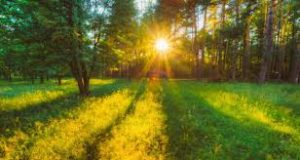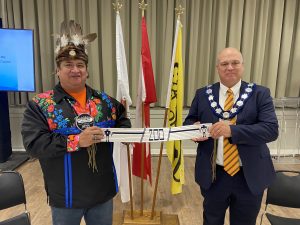 The origins of this trek are probably as old as the first human recognition of the regularity of seasonal change and the cycles of life that followed. If we lived in an equatorial zone we had two seasons to acknowledge: wet and dry. Our storytelling mythology reflected this reality of geography. Similarly, if we lived in a temperate climate, we experienced the four cycles of spring, summer, autumn and winter that created the birth, growth, harvest, death and rebirth cycles. These are found in most of our northern hemisphere current holyday ceremonies and religious mythologies. Add the thirteen cycles of the moon in a lunar year and you get the beginnings of all sacred traditions we created in our attempt to understand the great mysteries.
The origins of this trek are probably as old as the first human recognition of the regularity of seasonal change and the cycles of life that followed. If we lived in an equatorial zone we had two seasons to acknowledge: wet and dry. Our storytelling mythology reflected this reality of geography. Similarly, if we lived in a temperate climate, we experienced the four cycles of spring, summer, autumn and winter that created the birth, growth, harvest, death and rebirth cycles. These are found in most of our northern hemisphere current holyday ceremonies and religious mythologies. Add the thirteen cycles of the moon in a lunar year and you get the beginnings of all sacred traditions we created in our attempt to understand the great mysteries.
The Equinox Treks are reflective ones, acknowledging the equal balance of day and night, the light and the dark of life, the Return of the Sun King and the Departure of the Sun King. This a time for personal soul searching, a reexamination of goals, a celebration of returning life on the one hand, the asking of Gaugin’s three big questions on the other hand:
“Where do we come from? What are we? Where are we going?”
Whereas the Winter Solstice Trek on the shortest day of the year is a journey into the dark night of the soul, the Summer Solstice Trek on the longest day of the year is a celebration of the sensory – yes touch, taste, smell, sight, and sound but also the deeper senses like a sense of wonder, and a sense of belonging, and a sense of ecstasy.
In the beginning before the days of satellites and hard science, the Treks often lasted three days or more to ensure the traveler covered the time of the sacred seasonal change. Now most of us are lucky if we can put a day aside for each of those journeys. If we can, here’s a guide.
*****
We wake up in the very early morning, before the sunrise has even lightened the sky. We check the pack we had prepared the night before – water, fruit, biscuits, our favourite granola, knife, matches/lighter, moderate first aid kit, small sketch pad and pencil. On these treks there is no camera, no phone on, no watch. All the images we want to save will be stored in memory, like a slideshow in our mind. All the minute details we will record on our sketch pad, taking the time to truly see. We will have left our starting and ending point with a friend if we are going solo. But this is a trek best shared with a friend where a single look or touch between us says: How wonderful it is – this sense of life here.
We have researched our starting point where our trailhead begins, and have a bearing on where we should be heading to be safely out of the “wilds” before full darkness falls, But there is no designated route. That will be discovered. “Where are we?” Here. “What time is it?” Now.
We begin our trek in almost total darkness as we leave our trailhead. We walk carefully, slowly to let our eyes adjust to the details of the fforest around us. As the sun rises, the colours brighten, the shadows grow shorter and new details are revealed. We stop whenever something arouses our curiosity. We may sketch or simply absorb the moment. We stop to drink when we are thirsty or eat when we are hungry. There is little speech between us – rather, there is an intimate sharing of each discovery. We will change direction at a whim as something catches our attention, each taking turns leading the trek. When the sun is high we take a lunch break, lie back and rest.
Refreshed, the journey continues with always a new discovery to share along the way, a new memory to hold. Gradually, the sunlight begins to fade and we begin the slow circle back to our trailhead. We will arrive in darkness. But that is not the end of a Solstice Trek. Now we will go to a feast, to celebrate and talk about the discoveries of the longest day of the year.
And then to sleep, perchance to dream.
*****
In the true John Muir style of the Trek, the walk is done in pure wilderness where other humans are not encountered. That is very difficult for those of us in the GTA. so we do the best we can with local conservation areas or trails like the Bruce Trail or magical parks like Mono Cliffs. There are still oases of wild yet to be discovered and perhaps best done on a slow, wandering, wondering sunrise to sunset journey.
The way I see it.
*****
Skid Crease, Caledon
*****
Footnote: A variation on this theme was designed by our friend and neighbour Pam Leudke, who simply leaves her home in the dark on the day of the Solstice and heads out down the local Humber Valley Heritage Trail and beyond. She walks until the sun sets, often with a friend, and then calls for a pick-up wherever the darkness finds her. Her route is usually not in complete wilderness but passes through small communities on the way with stops at shops and local eateries, nicely combining a little bit of culture with the natural spaces of our local area..


 Then came the temper-tantrum truckers who terrorized Ottawa for three weeks because they couldn’t handle the mask or the needle. We had Conservative members of Parliament cheering them on from the bridges of Ottawa. We had to bring in the Emergencies Act to get them out of town because the local police felt helpless to stop the honking diesel fume spewing trucks, and the harassment of local citizens.
Then came the temper-tantrum truckers who terrorized Ottawa for three weeks because they couldn’t handle the mask or the needle. We had Conservative members of Parliament cheering them on from the bridges of Ottawa. We had to bring in the Emergencies Act to get them out of town because the local police felt helpless to stop the honking diesel fume spewing trucks, and the harassment of local citizens. Last night, January 11, 2022, the temperature in Caledon dropped to -21 degrees Celsius and -25 if you factor in the wind chill. At these temperatures the unsheltered human body goes through a sequence from frost nip to frostbite to hypothermia. We begin to shiver uncontrollably to keep our body warm. Within one hour the heart stops pumping blood to our extremities concentrating the life giving warmth around our vital organs. By the end of three hours, the brain shuts down, the heart stops beating and we freeze to death. Last night Environment Canada issued an Extreme Cold Weather Alert for all of Canada except BC, They are getting hit with more rain, and flooding, and mudslides. The new normal.
Last night, January 11, 2022, the temperature in Caledon dropped to -21 degrees Celsius and -25 if you factor in the wind chill. At these temperatures the unsheltered human body goes through a sequence from frost nip to frostbite to hypothermia. We begin to shiver uncontrollably to keep our body warm. Within one hour the heart stops pumping blood to our extremities concentrating the life giving warmth around our vital organs. By the end of three hours, the brain shuts down, the heart stops beating and we freeze to death. Last night Environment Canada issued an Extreme Cold Weather Alert for all of Canada except BC, They are getting hit with more rain, and flooding, and mudslides. The new normal.